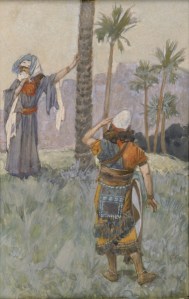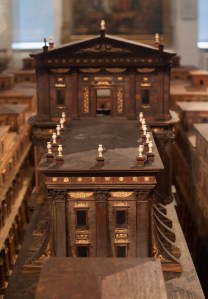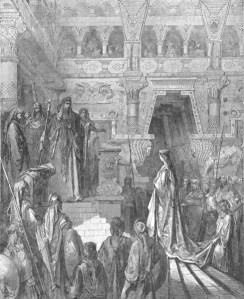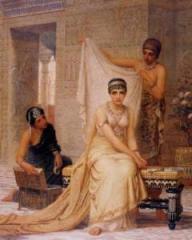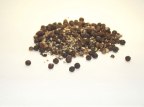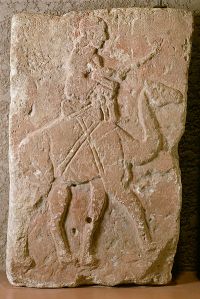Then Elimelech, Naomi’s husband, died; and she was left, and her two sons. Now they took wives of the women of Moab: the name of the one was Orpah, and the name of the other Ruth. And they dwelt there about ten years. Then both Mahlon and Chilion also died; so the woman survived her two sons and her husband (Ruth 1:3-5).
Naomi had arrived in Moab never suspecting the twists and turns her life would take during the next ten years. Now she found herself robbed of the emotional and physical support of not only her husband, but her two sons as well. In her homeland this would have been difficult enough, but finding herself bereft in a foreign land left her vulnerable, facing a uncertain future. It was only natural that she should think of home—Bethlehem in Judah.
She was not entirely alone—her daughters-in-law were quite devoted to her, and she still had her God, although Naomi agonized that perhaps she had fallen from His favor in light of her sad circumstances. Ruth and Orpah were well aware of her dedication to Israel’s God, as they must have seen it demonstrated numerous times over their years together as a family.
Weighing her options
By her own admission, Naomi was past the time of child-bearing. She knew that chances of remarriage, especially in Moab (and likely in her country as well), had she been so inclined, were virtually non-existent. If she went back to Judah, her husband had extended family there, so potentially she could have emotional support and even, perhaps, some rights of inheritance; she would be back in the land of her God; and if worse came to worse, there were provisions in Israel’s law to take care of widows, orphans, strangers, and the poor (Deuteronomy 14:28-29; 24:19-21).
Decisions. How to close down her home, and arrange for travel. Then there was the matter of Ruth and Orpah, both of whom felt a responsibility for her welfare, and she, for theirs. What should she do? What should they do?
A parting of the ways
News from home gave her the answer. By God’s grace, the famine had finally ended, and there was no real reason to remain in Moab. Informing Orpah and Ruth of her decision was no doubt emotional, but still they insisted on going with her. And so it was that the three widows found themselves on the road to Bethlehem, embarking on a journey not only fraught with potential dangers from roving bandits and miscreants along the way, but one which also posed many unknowns concerning what lay ahead.
That, however, is not what troubled Naomi most. She was quite concerned for the futures of her daughters-in-law. They would be foreigners in Judah, widows without any means of support or probable prospects for marriage—the plight she herself was fleeing.
She pleaded with them, “Go, return each to her mother’s house. The Lord deal kindly with you, as you have dealt with the dead and with me. The Lord grant that you may find rest, each in the house of her husband…” (1:8-9).

Naomi entreating Ruth and Orpah to return to the land of Moab by William Blake, 1795 (Photo credit: Wikipedia)
She kissed them and wept.
They cried in protest.
She reasoned, “Turn back…are there still sons in my womb, that they may be your husbands?”
Naomi cherished them both—they were like her very own daughters (1:11-13). They loved her in return, each in her own way.
Eventually a tearful Orpah[1] conceded, kissed Naomi one last time, and returned to the sanctuary of her parents’ home.
Ruth, however, was another matter.
To be continued….
[1] Orpah, Chilion’s wife, is only mentioned in a few verses in Ruth 1, and then she disappears from the pages of the Bible. People have tried to “flesh” her out, but there is little to go on. The Woman’s Study Bible, in its Topic titled “Orpah, the Daughter-in-Law with a Wavering Faith,” says her name has several meanings: fawn, double-minded, nape of the neck (interpreted to indicate stubbornness or being self-willed). Hence, to some, her actions reflected the negatives attached to her name—she left Naomi for entirely selfish reasons. Even the title of the Topic on Orpah presents a definite bias with regard to her actions. However, as mentioned in the introductory post on The Story of Ruth, depending on names and their meanings is quite subjective.
Some draw attention to the statement that Orpah kissed Naomi, whereas Ruth clung to her, inferring a difference of the depth of attachment. The manner in which Orpah returned is in itself viewed subjectively: She was either obediently complying with Naomi’s urging, or she was selfishly looking out for her own future, as well as returning to the religion of her people.
Since there is no definitive statement as to her motive, people continue to construct arguments supporting their particular interpretation.


